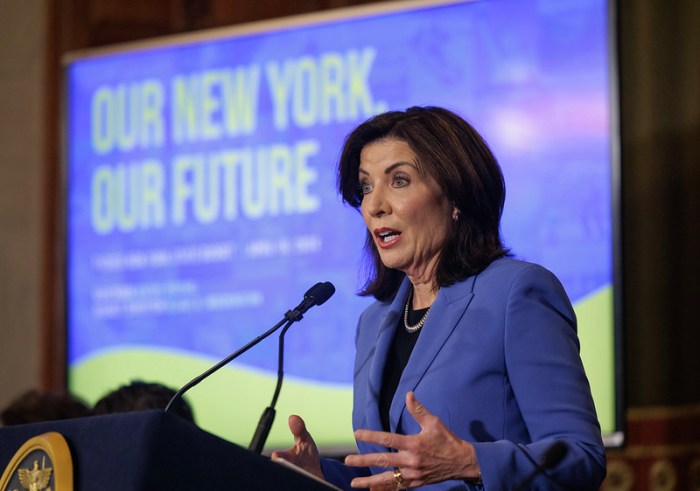
Lawmakers, housing advocates and tenants say they are gearing up for a major battle over the future of the nearly 1 million rent stabilized city apartments.
Although the Urstadt Law of 1971 regulating the units won’t expire until June, experts say the question of how to improve it for today’s tenants and landlords is going to be the biggest legislative debate of the year.
“There will be a more public battle than in the past,” said Harold Shultz, a consultant at Citizens Housing and Planning Council.
The city has lost roughly 230,000 rent controlled and stabilized apartments since the 1980s.
Without rent stabilization, “the city wouldn’t continue to exist,” said City Councilman Jumaane Williams, who chairs the housing committee. “There is no way we can belittle how important it is.”
Apartment owners, however, are pushing for less regulating in a bid to counter high taxes and ownership fees. Frank Ricci, director of government affairs for the Rent Stabilization Association, said that the economic impact of rent stabilization is worsening because of those rising costs.
“They want to stay in business but unless they get some relief from the city … something’s going to give ,” he said of owners.
Rent-stabilized tenants have a median household income of $36,600 according to a study by the Furman Center for Real Estate and Urban Policy.
Housing advocates want Albany to “maintain this program and bring in some consideration of income levels in the city,” said Margaret Newman, the executive director of the Municipal Arts Society.
It is unlikely that the state legislature will let the Urstadt law expire; elected officials made few revisions during its last renewal period in 2011. Housing advocates predict a similar outcome following this year’s debate, but still aim to encourage lawmakers to adjust the laws.
There are more rules for determining if an apartment is rent stabilized than there are for rent control, which only applies to tenants who have lived continuously since before July 1971 in apartments built prior to 1947.
Most rent stabilized units are in non co-op or condo buildings built between 1947 and 1974 or in buildings where the owners received a tax credit for offering the lower rates. Rents cannot exceed $2,500 a month and the tenant’s gross income must not exceed $200,000. The increases are determined by an annual vote by the Rent Guidelines Board.
Naturally, rent-controlled apartments have been on a steady decline since the ’80s, when there were more than 285,000 apartments compared to close to 38,000 in 2011, according to the Furman Center. Rent-stabilized apartments, however did not see a major decline until the last decade.
State Assemblyman Brian Kavanagh (D), who represents Stuyvesant Town and Peter Cooper Village, said there are several lingering loopholes in the law that contributed to the loss of more than 55,000 rent-stabilized units citywide between 2002 and 2011. As an example, Kavanagh pointed to the fact that landlords can raise the rent above the $2,500 threshold if the unit is vacant.
“It’s become increasingly the case they are now an incentive for a landlord on how they can kick people out of their apartments,” he said.
Fitzroy Christian, 68, who has lived in a rent stabilized apartment in the Mt. Eden section of the Bronx since 1976, said he was the victim of another loophole years ago that cost him his low rent.
A fire to a neighbor’s apartment in 1987 caused minor damage to his two-bedroom unit and as a result his rent went up $20 a month to cover the costs.
“Even though it was not my fault I was subjected to the raise,” he said.
Christian, who is retired and an advocate with the nonprofit Community Action for Safe Apartments, said other tenants across the city also have had their rents raised because owners passed the costs of the work of minor renovations or improvements to them.
Other elected officials and advocates, however, say the owners face their own set of detrimental loopholes. State Sen. Phil Boyle, a Suffolk Republican who was on the housing committee during the last legislative session, said he sympathizes with rent-stabilized tenants but prefers a model that hews more closely to free markets.
Boyle said many rent-stabilized landlords aren’t multimillion dollar developers who own dozens of properties across the city. They’re looking to make ends meet too, he said.
“I want to make sure that landlords invest their hard-earned money into housing creation,” he said.
Boyle said he hoped for a solution that meets the needs of both tenants and landlords long before June and predicted that major discussions would begin immediately. City advocates expect rallies and a huge engagement campaign.
“Oh yeah, we’re going to gear up for that,” Councilman Williams said. “This is a topic that no one can ignore this year.”
The Urstadt Law 411
The Urstadt Law that created the rent stabilization rules in the city has been in effect since 1971. The rules have been mostly unchanged since then.
Here’s a rundown of how they work:
Units can be rent stabilized if:
1) They are in non-co-op or condo buildings with at least six units that were generally built between Feb. 1, 1947 and Jan. 1, 1974 and rented below $2,500.
2) An owner or developer received tax benefits after they built or renovated a building.
If the market rate for the rent goes above $2,500 or if the household makes more than $200,000, a landlord can make a motion to deregulate the apartment.
The city’s Rent Guidelines Board votes annually on one year and year rent increases.
Rent stabilized units in 2011, according to a study by NYU’s Furman Center.
Rental units in the city: 2,172,634
Rent stabilized: 986,840
Rent controlled: 38,374
Borough breakdown of rent stabilized/controlled units:
Bronx: 231,754
Brooklyn: 306,374
Manhattan: 284,089
Queens: 194,536
Staten Island: 8,461
Median income for market rate apartment renter: $52,260
Median income for rent stabilized/rent controlled rate apartment renter: $36,600.
















